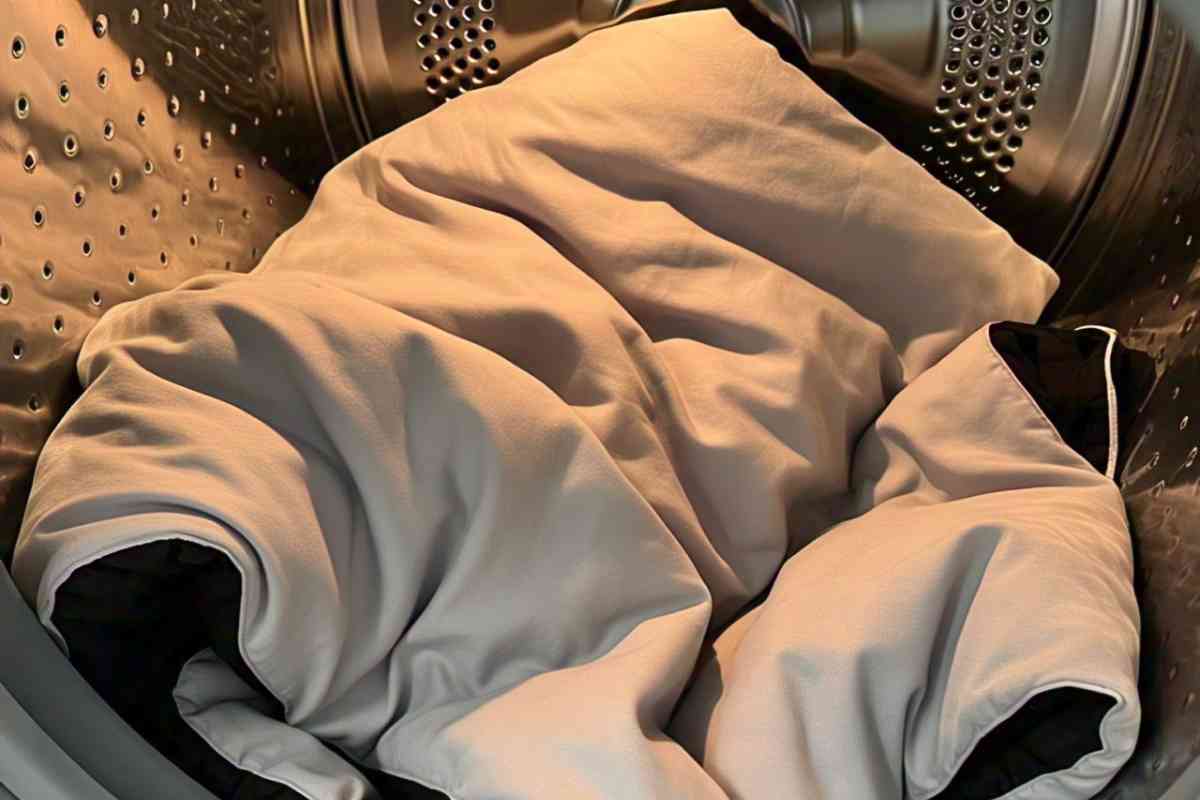Can You Put a Weighted Blanket in The Dryer?

Wondering if you can toss your weighted blanket in the dryer? You’re not alone. Drying it the wrong way can shrink, damage, or even ruin your blanket.
But don’t worry, we’ve got you covered. In this guide, you’ll learn exactly what to do (and what to avoid) to keep your blanket soft, safe, and long-lasting.
Table of contents
Key Takeaways
Check the care label before drying to ensure your blanket is dryer-safe.
Always use a low or medium heat setting to avoid fabric damage and shrinkage.
Dry your blanket separately to prevent strain on the dryer and maintain fabric integrity.
For even drying, flip your blanket frequently and avoid overloading the dryer.
Air drying is a safe alternative, just lay flat, avoid direct sunlight, and ensure proper airflow.
Can You Put a Weighted Blanket in the Dryer?
- Start by reading the care label on the blanket: Before doing anything, check the tag. It tells you if your blanket is safe to go in the dryer or not.
- Use low heat if the label says it’s okay: If the care label allows it, always choose a low heat setting. High heat can ruin the blanket.
- High heat can melt some fillings inside: Plastic pellet fillings can melt or lose shape in high temperatures, so keep it cool in the dryer.
- Some fabrics are strong, but others need care: Cotton and polyester usually handle the dryer well. Delicate materials like minky or fleece can get damaged or start pilling.
- Drying it the wrong way can ruin the blanket: If you use the wrong settings, the filling can shift or clump, making the blanket feel uneven and uncomfortable.
- Blankets with glass beads dry more safely: Glass beads are tougher than plastic and don’t get damaged as easily, making them safer to dry on low heat.
- Drying time depends on what it’s made of: Most weighted blankets take 2 to 3 hours to dry on low heat. Lighter fabrics like cotton dry faster.
- Taking it slow helps your blanket last longer: Gentle drying protects the blanket over time. Don’t rush it, treat it with care to make it last.

Do Weighted Blankets Shrink in the Dryer?
- Weighted Blankets Can Shrink in the Dryer: Weighted blankets can shrink in the dryer, especially when exposed to high heat. The heat causes the fabric to tighten and shrink in size.
- Fabric Type Affects Shrinkage: Cotton and bamboo fabrics are more likely to shrink than synthetic materials like polyester, which generally hold their shape better.
- Shrinkage Varies Between Different Blankets: Not all weighted blankets shrink the same way. Some may shrink slightly, while others can lose a more noticeable amount of size depending on their fabric and construction.
- Fixing Shrinkage Through Soaking and Stretching: If your blanket shrinks, soaking it in water can help loosen the fibers. Gently stretching the blanket while it’s still damp can help return it to its original size.
Can Drying a Weighted Blanket Damage Your Dryer?
Drying a weighted blanket in your home dryer can put strain on the dryer drum, especially if it’s not designed for bulky loads.
Most home dryers aren’t built to handle items over 20 pounds, so check your blanket’s weight first.
Overloading the dryer can cause the motor to overheat or break over time. Doing this repeatedly can slowly wear out your dryer. To prevent damage, ensure you’re not overloading the machine.
Is It Safe to Dry a Fleece Weighted Blanket?
Drying a fleece weighted blanket can be tricky, but with the right approach, it doesn’t have to cause any damage.
Fleece typically doesn’t shrink when dried correctly, especially on low heat. However, high heat can damage the fabric, making it lose its softness.
Always opt for a low heat setting. If your fleece blanket has glass beads inside, they won’t melt in the dryer, but make sure to check the material blend for dryer safety.
Can You Dry a Weighted Blanket With Metal beads?
-
Drying a Weighted Blanket with Metal Beads is Possible: Drying a weighted blanket with metal beads, often made of steel for durability and weight, in the dryer is possible, but you need to be cautious.
-
Use Low Heat to Prevent Damage: Use a low heat setting to prevent damage to the beads and ensure the blanket dries evenly. High heat can cause the beads to break and the blanket to lose its shape.
- Check for Clumping and Uneven Drying: If you use a clothes dryer, check for any clumping or uneven drying. This can cause areas of the blanket to stay damp or unevenly distributed.
Can You Dry a Weighted Blanket With Glass Beads?
- Drying a Weighted Blanket with Glass Beads is Safe with Care: Drying a weighted blanket with glass beads is generally safe as long as you follow a few key guidelines.
- Use Low or Medium Heat to Protect the Beads: Always opt for a low or medium heat setting. High heat can break the beads or shrink the fabric, so keep the heat gentle.
- Gentle Cycles Help Preserve the Blanket: Choose the delicate or gentle cycle for drying. This setting will keep the blanket in good condition while ensuring an even dry.
- Dry the Blanket Alone to Avoid Damage: Dry your blanket by itself to prevent strain on the fabric and beads. This will protect the quality of your blanket and other items in the dryer.
- Spread Beads Evenly to Prevent Clumping: Before drying, make sure the beads are spread out inside the blanket. This helps avoid clumping and ensures a more consistent dry.
Is It Okay to Put a Weighted Blanket With Plastic Pellets in the Dryer?
- Avoid High Heat Settings: When drying a weighted blanket with plastic pellets, heat can damage the pellets. Avoid using high heat.
- Use Low or Medium Heat to Protect Pellets: Always set your dryer to low or medium heat to keep the plastic pellets safe from damage.
- Dry in Short Intervals for Even Drying: Dry the blanket in short intervals to help the pellets dry evenly without overheating.
- Consider Flat Drying as a Safer Option: If unsure about using the dryer, laying the blanket flat on a clean surface is safer and prevents damage.
- High Heat Can Melt the Pellets: Using high heat can cause the plastic pellets to melt, ruining the blanket’s feel and weight.
Common Dryer Mistakes That Could Ruin Your Blanket
Avoid Overloading the Dryer to Ensure Even Drying and Prevent Fabric Damage
- Overloading the Dryer Leads to Uneven Drying: Overloading the dryer can lead to uneven drying, which may leave your weighted blanket damp. Air needs to circulate properly for effective drying.
- Too Much in the Dryer Can Damage Your Blanket: If the blanket is too crowded in the dryer, the fabric can get damaged, and the blanket may remain heavier and wetter than expected.
Do Not Use High Heat Settings That Can Shrink or Weaken Blankets
High heat can shrink or weaken your weighted blanket’s fabric and cause internal filling to break down.
Excessive heat can lead to uneven drying and fabric damage. Always use a low or medium heat setting to protect the blanket’s material and filling.
To stay safe, you can use a thermocouple to monitor the dryer’s internal temperature, if it climbs above 250°F, it may signal a lint buildup that needs cleaning before it causes heat damage.
Always Add a Fabric Softener Sheet to Reduce Static and Maintain Softness
- Fabric Softeners Keep Your Blanket Soft and Comfortable: Using fabric softeners helps keep your blanket soft, making it more comfortable to cuddle up in.
- Fabric Softeners Reduce Static for a Better Experience: Static can be annoying, but fabric softeners reduce it, giving you a smoother, more comfortable blanket.
- Don’t Overuse Dryer Sheets to Avoid Residue: Using too many dryer sheets can leave behind a residue, making your blanket feel less soft. Be mindful of how many you use.
Follow the Care Label Instructions to Keep Your Blanket in Good Condition
Always refer to the care label for specific drying instructions. Ignoring these instructions could lead to shrinking, fabric damage, or changes in texture.
Avoid Drying Blankets With Heavy Items to Prevent Stretching or Damage
Heavy items can stretch the fabric or cause uneven drying. To prevent this, dry your blanket separately or with lighter items to maintain the structure and fabric of the blanket.
Clean the Lint Trap Before Every Load to Improve Drying and Safety
- Clogged Lint Trap Slows Drying and Increases Fire Risk: A clogged lint trap, which captures lint and small debris, slows down the drying process, wastes energy, and increases the risk of a fire.
- Full Lint Trap Leads to Longer Drying Times: When the lint trap is full, airflow becomes restricted, causing longer drying times, especially for heavy items like blankets.
- Regular Cleaning Improves Dryer Efficiency and Safety: Regularly cleaning the lint trap not only helps your dryer work more efficiently but also enhances safety by preventing overheating.
- How to Clean the Lint Trap for Better Performance: To keep it in top shape, gently remove lint using a soft-bristle brush or vacuum hose, and check the exhaust vent for any hidden debris.
Use the Correct Dryer Cycle to Protect Your Blanket’s Shape and Material
Ensure the dryer cycle you choose matches the fabric type of your weighted blanket. High heat can warp the fabric or damage the filling, while too low a heat setting may leave your blanket damp. Select a low or medium heat cycle for optimal results.
Summary
To keep your weighted blanket in great shape, avoid overloading the dryer, use low heat, clean the lint trap, follow care labels, and dry it separately. Stick to gentle cycles and add fabric softeners or dryer balls to maintain softness and reduce static.

|
Mistake |
Impact |
Solution |
| Overloading the Dryer |
Uneven drying, fabric damage, excessive strain on dryer |
Dry blankets separately or with lighter items |
| Using High Heat Settings |
Shrinkage, weakening of fabric, internal filling damage |
Always use low or medium heat settings |
| Ignoring Care Label Instructions |
Fabric shrinkage, fill breakdown |
Always follow the care instructions on the label |
| Drying with Heavy Items |
Stretching of fabric, uneven drying |
Dry the blanket with lighter items |
| Skipping Lint Trap Cleaning |
Reduced drying efficiency, fire hazard |
Clean lint trap before every load |
How to Air Dry a Weighted Blanket Properly
Shake Out Excess Water to Help the Blanket Dry Much Faster
Shake the blanket right after washing to help remove excess water and speed up drying.
This is important because heavy blankets hold a lot of water, and sitting too long can cause mold to form.
Shaking helps the blanket dry evenly. Keep in mind that air-drying takes 24–48 hours due to the blanket's density, so it’s crucial to give it enough time to dry thoroughly.
Lay the Blanket Flat to Prevent Fill From Shifting or Clumping
To prevent fill from shifting or clumping, lay the blanket flat on a clean surface like a drying rack or bed.
For better results, placing it on a mesh drying rack can help retain its shape while also speeding up the drying process.
Moisture tends to collect at the bottom of heavier fabrics, so turning them occasionally ensures they dry more evenly and quickly. Avoid hanging it, as the weight can cause uneven drying.
Use a Ventilated Area to Allow Proper Airflow During Drying Process
Good airflow is key to preventing mildew and allowing your blanket to dry efficiently. Use fans, open windows, or dry your blanket outdoors in a breezy spot.
Flip the Blanket Often to Ensure Even Drying on Both Sides
Flip your blanket every few hours to help it dry evenly on both sides. By doing this, you prevent one side from staying damp for too long, which could cause a musty smell.
Keeping both sides exposed to air ensures the blanket dries fully, leaving it fresh and ready to use.
Avoid Direct Sunlight to Protect Fabric and Prevent Fading Over Time
While it might seem like a good idea to dry your blanket outside, direct sunlight can damage the fabric and cause fading over time.
Prolonged UV exposure can also weaken the fibers, making them less durable and more prone to wear.
To preserve both the color and integrity of your blanket, always dry it in a shaded area.
Smooth Out Lumps to Keep the Fill Evenly Distributed While Drying
Check for any clumps in the fill while the blanket is drying and gently smooth them out. This will help the filling stay evenly distributed and prevent uneven drying.
Dry Completely Before Storing to Prevent Mold, Mildew, and Musty Odors
Never store a damp weighted blanket, as even a little moisture can cause mold or mildew. Always perform a touch test to ensure it’s completely dry before putting it away.
Summary
To air dry your weighted blanket properly, shake out excess water, lay it flat, use good airflow, and flip it often. Avoid sunlight, smooth out lumps, and make sure it’s fully dry before storing. This keeps your blanket fresh and long-lasting.

FAQs
Is It Safe to Dry a Weighted Blanket Outside in the Sun?
Sunlight can fade the fabric and weaken it over time. If drying outside, choose a shaded area, flip the blanket halfway through, and avoid harsh midday sun to protect the blanket’s material.
How Long Does It Take to Dry a Weighted Blanket in the Dryer?
Drying usually takes 2 to 4 hours, depending on the blanket’s weight and fabric. Drying on low heat may take longer but helps protect the fabric and filling.
Can You Use High Heat to Dry a Weighted Blanket?
High heat is not recommended, as it can damage the fabric, melt the filling, and cause shrinkage. Always opt for low to medium heat for the safest drying.
What Dryer Setting Is Best for a Weighted Blanket?
Use a low to medium heat setting and choose a gentle cycle for the best results. This will help preserve the fabric and filling while ensuring proper drying.




